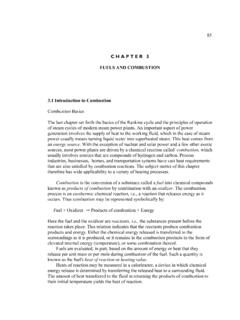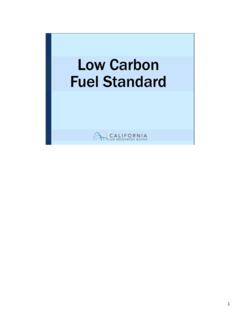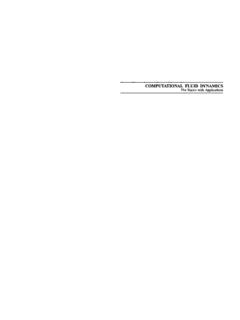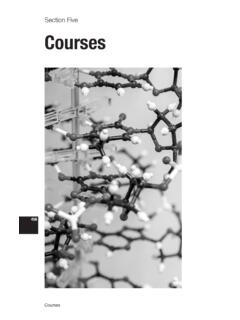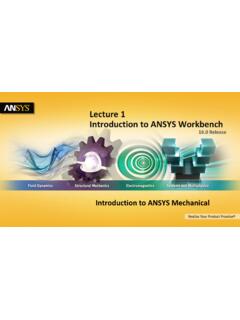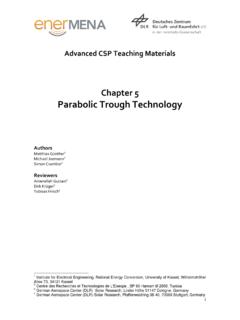Transcription of THERMODYNAMICS 201 TUTORIAL No.8 COMBUSTION …
1 THERMODYNAMICS 201 TUTORIAL COMBUSTION OF FUELS On completion of this TUTORIAL you should be able to . write down COMBUSTION equations.. solve the oxygen and air requirements for the COMBUSTION of solid, liquid and gaseous fuels.. determine the products of COMBUSTION .. determine the air/fuel ratio from the products of COMBUSTION .. solve problems involving energy released by COMBUSTION ..solve problems involving dissociation of products.. solve past paper questions. Let's start by revising the basics. 2 1. INTRODUCTION COMBUSTION is the process of chemical reaction between fuel and oxygen(reactants). The process releases heat and produces products of COMBUSTION . The main elements which burn are : CARBON HYDROGEN SULPHUR The heat released by 1 kg or m3 of fuel is called the calorific value.
2 The oxygen used in COMBUSTION processes normally comes from the atmosphere and this brings nitrogen in with it which normally does nothing in the process but makes up the bulk of the gases remaining after COMBUSTION . The main elements in COMBUSTION are then : Symbol Atomic Mass Molecular Mass Product Carbon C 12 CO2 Hydrogen H2 1 2 H2O Sulphur S 32 SO2 Oxygen O2 16 32 Nitrogen N2 14 28 If the water formed during COMBUSTION leaves as vapour, it takes with it the latent heat of evaporation and thus reduces the energy available from the process. In this case the calorific value is called the lower Calorific value (LCV). If the products cool down after COMBUSTION so that the vapour condenses, the latent heat is given up and the calorific value is then the higher calorific value (HCV).
3 Solid and liquid fuels are normally analysed by mass to give the content of carbon, hydrogen, sulphur and any other elements present. Often there is silica, moisture and oxygen present in small quantities which have some effect on process. The silica leaves slaggy deposits on the heat transfer surfaces in boilers. Gaseous fuels are normally analysed by volumetric content and are in the main hydrocarbon fuels. For purposes of calculation, the content of air is considered to be : VOLUMETRIC GRAVIMETRIC Oxygen 21% 23% Nitrogen 79% 77% 3 The sulphur content of the fuel is considered to be a pollutant and so undesirable. The theoretically correct quantity of air or oxygen required to just exactly burn the fuel expressed as a ratio to the fuel burned, is called the STOICHIOMETRIC RATIO.
4 In practice it is found that not all the oxygen in the reactant reaches the fuel elements and that excess air is required in order to ensure complete COMBUSTION . This results in oxygen appearing in the products. If too little air or oxygen is supplied, the result is incomplete COMBUSTION resulting in the formation of carbon monoxide CO instead of carbon dioxide CO2. The resulting products contain water H2O. Industrial equipment for measuring the contents of the products usually remove the water from the sample and the products are then called the dry products. 2. COMBUSTION CHEMISTRY SOLID AND LIQUID FUELS In the case of solid and liquid fuels, we do the COMBUSTION of each element separately.
5 The important rule is that you must have the same number of atoms of each substance before and after the process. This may be obtained by juggling with the number of molecules. CARBON C + O2 = CO2 Mass ratio 12 + 32 = 44 Hence 1kg of C needs 32/12kg of O2 and makes 44/12kg of CO2 HYDROGEN 2H2 + O2 = 2H2O Mass ratio 4 + 32 = 36 Hence 1kg of H2 needs 8kg of O2 and makes 9 kg of H2O SULPHUR S + O2= SO2 32+32 = 64 Hence 1 kg of S needs 1kg of O2 and makes 2kg of SO2. 4 GASEOUS FUELS Typical hydrocarbons are : Methane CH4 Ethane C2H6 Propane C3H8 Butane C4H10 Pentane C5H12 Hexane C6H14 Heptane C7H16 Octane C8H18 Ethene C2H4(Ethylene) Propene C3H6 (Propylene) Ethyne C2H2 (Acetylene) Benzenol C6H6 (Benzene) Cyclohexane C6H12 The COMBUSTION equation follows the following rule : CaHb + (a+b/4)O2 = (a)CO2 + (b/2)H2O If this results in fractional numbers of molecules, then the whole equation may be multiplied up.
6 WORKED EXAMPLE Write out the COMBUSTION equation for C8H18 SOLUTION C8H18 + (8+18/4)O2 = 8CO2 + (18/2)H2O C8H18 + 12 O2 = 8CO2 + 9H2O 2C8H18 + 25O2 = 16CO2 +18H2O There are other gases which burn and the main one to know about is Carbon Monoxide (CO) which is partially burned carbon. The equation for the COMBUSTION of CO is : 2CO + O2 = 2CO2 5 3. COMBUSTION BY MASS The only rule to be observed in deducing the quantities of each substance is the law of conservation of mass. The proportions of the mass is that of the molecular masses. This is shown in the following example. WORKED EXAMPLE A fuel contains by mass 88% C, 8%H2, 1%S and 3% ash (silica). Calculate the stoichiometric air.
7 SOLUTION CARBON C + O2 = CO2 Mass ratio 12 + 32 = 44 Hence of C need (32/12) of oxygen. It makes (44/12) x = kg of carbon dioxide. HYDROGEN 2H2 + O2 = 2H2O Mass ratio 4 + 32 = 36 hence of hydrogen needs (32/4) x = of oxygen. SULPHUR S + O2= SO2 Mass ratio 32+ 32 = 64 Hence of sulphur needs of oxygen and makes of sulphur dioxide. TOTAL OXYGEN needed is + + = TOTAL AIR needed is = The STOICHIOMETRIC air/fuel ratio is 6 WORKED EXAMPLE If the air supplied is 20% more than the stoichiometric value, find the analysis of the dry products by mass. SOLUTION If 20% excess air is supplied then the air supplied is: 120% x = kg Oxygen is also 20% excess so x = is left over.
8 Nitrogen in the air is 77% x = List of products : Nitrogen = Carbon dioxide = Sulphur dioxide = Oxygen = Total dry product =100% It is of interest to note that for a given fuel, the % of any product is a direct indication of the excess air and in practice the carbon dioxide and/or oxygen is used to indicate this. This is important in obtaining optimal efficiency in a COMBUSTION process. 7 SELF ASSESSMENT EXERCISE No. 1 1. A boiler burns fuel oil with the following analysis by mass : 80% C 18% H2 2%S 30% excess air is supplied to the process. Calculate the stoichiometric ratio by mass and the % Carbon Dioxide present in the dry products. ( CO2) 2.
9 A boiler burns coal with the following analysis by mass : 75% C 15% H2 7%S remainder ash Calculate the % Carbon Dioxide present in the dry products if 20% excess air is supplied. ( CO2) 3. Calculate the % of each dry product when coal is burned stoichiometrically in air. The analysis of the coal is: 80% C 10% H2 5% S and 5% ash. ( , CO2 SO2) 8 4. COMBUSTION BY VOLUME First we need to revise gas mixtures and understand the meaning of VOLUMETRIC CONTENT. To do this we must understand Dalton's law of partial pressures and Avagadro's Law. First let us define the kmol. A kmol of substance is the number of kg numerically equal to the apparent molecular mass. For example 12 kg of Carbon is a kmol, so is 32 kg of O2 and 2 kg of H2 and 28 kg of N2.
10 The molecular mass of a substance is expressed as kg/kmol so the molecular mass of O2 , for example, is 32 kg/kmol. Avagadro's Law states : 1m3 of any gas at the same pressure and temperature contains the same number of molecules. It follows that the volume of a gas at the same p and T is directly proportional to the number of molecules. From this we find that the volume of a kmol of any gas is the same if p and T are the same. Dalton's law states: The total pressure of a mixture is the sum of the partial pressures. The partial pressure is the pressure each gas would exert if it alone occupied the same volume at the same temperature. Consider two gases A and B occupying a volume V at temperature T.










